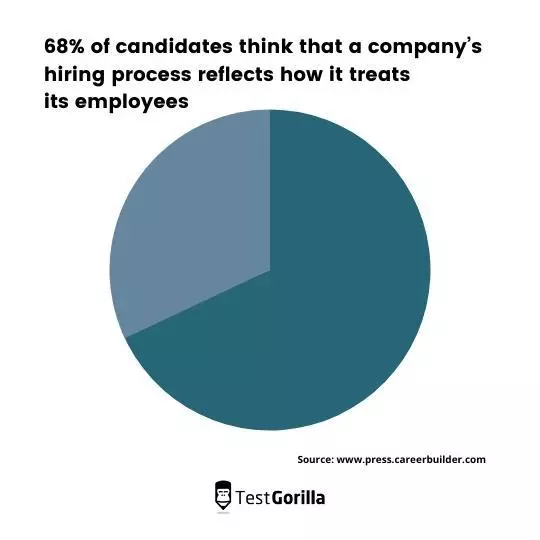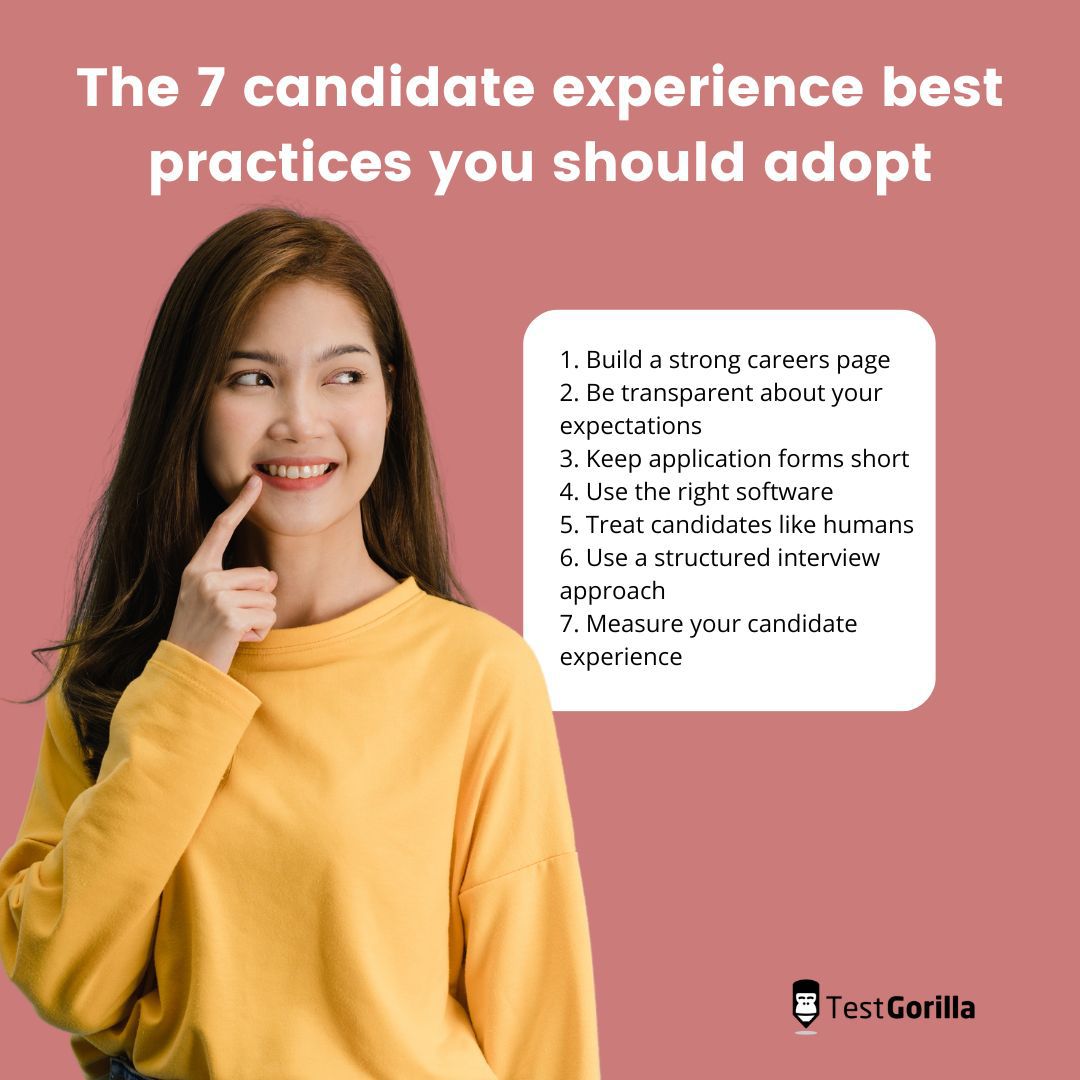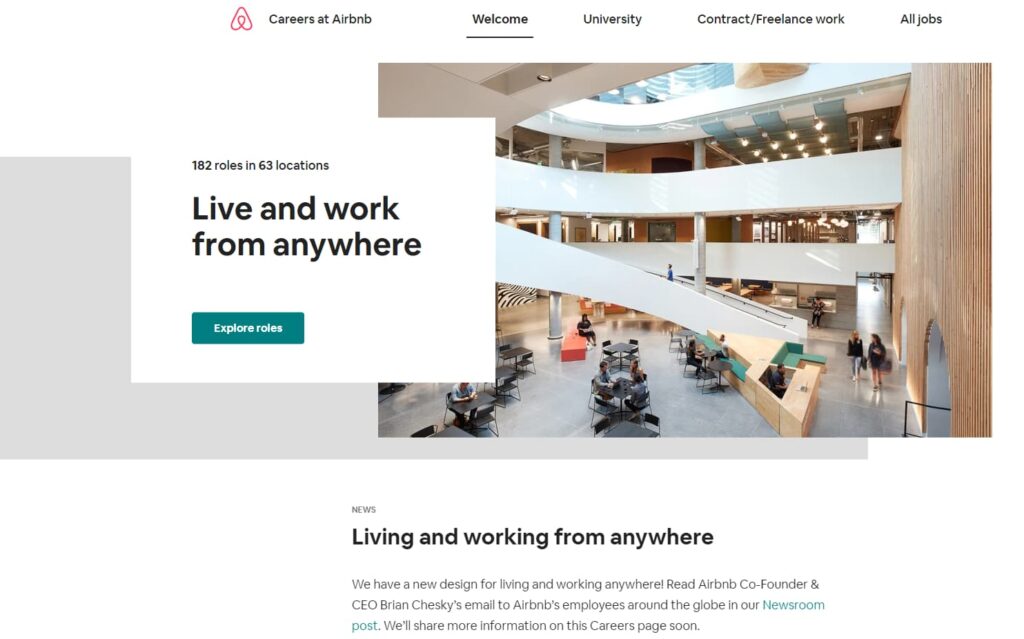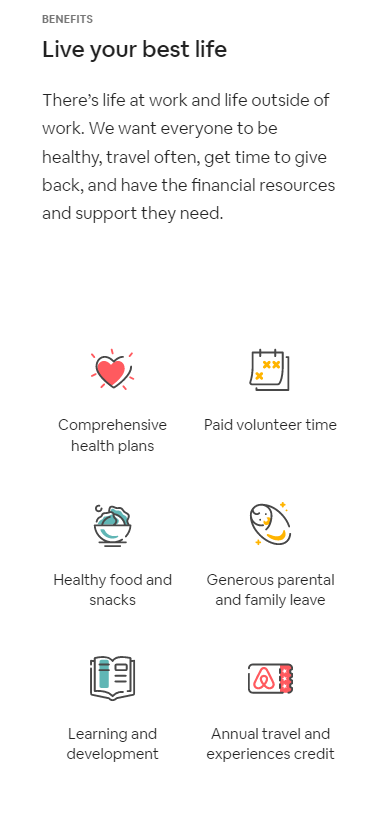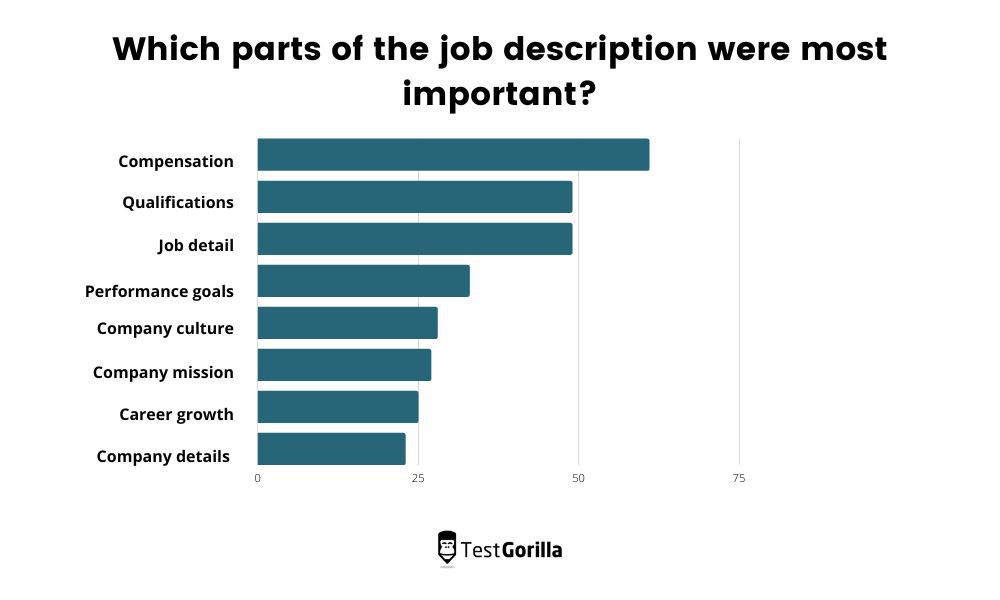Picture this: You’re on your way home from a job interview when you check your phone to see a rejection email – from the job you just finished interviewing for.
You call back to check if it was a mistake (it wasn’t) and ask why they wasted your time with an interview (no answer).
You’re probably feeling confused, frustrated, and angry that they wasted your time. You won’t be applying again or recommending them to friends. You might even give the company a bad review.
At least this is just a hypothetical scenario, right?
Nope, this actually happened to one candidate.[1]
If you want to hire top talent (and avoid your bad practices being aired on the Internet), you need to consistently deliver a great candidate experience. This is especially true in a candidate-driven market.
In this post, we’ll walk you through seven candidate experience best practices and how to implement them in your business.
Candidate experience 101
Candidate experience is how the people who apply to work at your organization perceive the hiring process. It starts from their first interaction with your business, which might be:
Seeing a job posting online
Getting a message from a LinkedIn recruiter
Receiving a referral from a friend
…and moves through the entirety of the application and interview process. It doesn’t stop with an acceptance or a rejection, either.
For successful candidates, the candidate experience continues into the pre-boarding and onboarding processes once you hire them.
For unsuccessful candidates, it concludes with rejection communications and any contact you have with them after their interview (more on this below).
A good candidate experience is all about making everyone who applies, regardless of the outcome of their application, feel respected and up-to-date with what’s happening in the hiring process.
Why does candidate experience matter?
The importance of the candidate experience to job seekers is obvious: Everyone wants to be treated with respect, especially when they put themselves out there by applying for jobs.
And, perhaps more importantly, most candidates believe that a company’s hiring process reflects how it values its people.[2]
Top talent will use the candidate experience to decide whether or not to take the job, so if you have an urgent position to fill, you’d better prioritize it.
In fact, if you offer a stellar candidate experience, you’ll stand out from competitors. Nearly 60% of job seekers have suffered a poor candidate experience in the past, so if you can build a reputation for good candidate experience, you’ll rise to the top.
The 7 candidate experience best practices you should adopt
So, how can you make sure you’re able to provide a positive candidate experience to all applicants?
In this section, you’ll find the seven most important candidate-experience best practices you can use in your hiring process to build a strong employer brand and attract the best talent.
1. Build a strong careers page
Like your client-facing pages, your careers pages need to communicate your company culture – what Bryan Adams (not the Canadian musician, the employer branding expert) calls the “give and get” proposition of your business.
A good careers page establishes your broad benchmarks for performance and what your employees will get for meeting these, such as:
Financial compensation
Professional development opportunities
A great work-life balance
A sense of purpose to the work they’re doing
Airbnb is a good example. Their careers page clearly articulates their workplace philosophy, which ties in closely with their central ethos as a business: global flexibility.
From the first glance, candidates know the most important selling point of Airbnb as an employer: the opportunity to live and work from anywhere. As they read on, it’s broken down further.
Perhaps even more importantly, the page is mobile-responsive.
Almost three-quarters of website users name a lack of responsiveness as a reason to exit a site – don’t miss out on top talent because your careers page is too hard to use on mobile!
2. Be transparent about your expectations
Transparency in the hiring process is essential to having happy candidates and happy hires.
It starts with the job ad: Clear, detailed job descriptions are a must. Make sure to include:
The job title
The purpose of the role: Why does this job exist in your company?
The tasks and duties required and how they’ll be performed
The level of responsibility and decision-making involved
Any budgetary or financial responsibilities
Any supervisory responsibilities
Required qualifications
…And, of course, the actual salary or salary range – none of this “competitive salary” business! A LinkedIn study[3] found that a clear description of compensation was the most important element of a job ad to applicants.
If candidates ask questions about the hiring process, answer them clearly, promptly, and honestly. Your careers page can help you here, too, by giving candidates detailed information on your hiring process and what to expect. Here’s an example from DigitalOcean:
There’s really no limit to how transparent you should be when it comes to the reality of the job you’re hiring for.
The chief marketing officer of ArcLight Cinemas offers top candidates the opportunity to do “reverse reference checks” on him. He introduces them to two of his past direct reports, usually including one who no longer works for the company, and encourages them to ask any and all questions they have about the experience of working for him.
The more candidates know about the company, the role, and the management style of their superiors, the less likely they’ll be to run for the hills in six months because it’s not what they signed up for.
3. Keep application forms short
We’ve all been there: You’re excited about a job posting, you click on the link to apply… then you see they want a resume, a cover letter, a recommendation letter from your high school gym teacher, your astrology birth chart, and a blood oath. You sigh and close the page.
We might have exaggerated a little, but the numbers don’t lie: 92% of job seekers never finish online job applications. So keep your forms short if you want applicants to make it through them.
Even better, you can replace resume uploads and application forms with pre-employment testing, where instead of just asking applicants to tell you their skills, you can let them show you.
On TestGorilla, for example, you can test for just about anything you would want from an applicant, from personality traits to programming skills. Take a look:
Skill or attribute type | Tests |
Situational judgment | Leadership and people management; Account management; Negotiation |
Personality and culture | Enneagram; Motivation; Culture add |
Technical or role-specific | Exploratory data analysis; Google Ads |
Language | Spanish (upper intermediate/B2); Swedish (intermediate/B1) |
These are just a few examples; you can explore the full test library here.
For applicants, this replaces the hours they might have to spend tailoring their CV and cover letter to your ad with a simple one-hour test.
For you, it will increase the accuracy of your hiring decisions. Over 80% of Fortune 500 companies already use psychometric tests for hiring, and of those, 81% say it makes for better hires. Additionally, skills tests enable you to objectively assess applicants’ knowledge and abilities and make better hires, faster.
But don’t just take our word for it – read about how Bain & Company improved their candidate experience with pre-interview testing here.
4. Use the right software
Using the right pre-employment skills assessment platform will help you build a positive candidate experience because it will enable you to:
Give applicants a way to prove their skills
Objectively assess candidates
Create a fair hiring process that’s fair and equitable
Show candidates that you value their skills above all else
Speed up recruitment and filter unqualified candidates early on (and not waste anyone’s time)
You’ll also need a good Applicant Tracking System, or ATS, on top of a sharp pre-employment testing platform.
An ATS’s job is to simplify the hiring process and take the unwieldy manual jobs out of your hands. This includes:
Posting to job boards
Scanning resumes
Scheduling interviews
Creating interview templates
Basically, the boring stuff that somehow takes up half your day.
Choosing the right ATS for your business can be challenging because it’s a crowded job market, but as a baseline, your ATS should allow you to:
Create a branded portal for use by internal and external applicants
Customize the input fields and add screening questions and skills tests
Filter candidates to create a shortlist
Schedule, conduct, and take notes during interviews
Analyze your hiring performance
Popular ATS providers include SmartRecruiters, Lever, and Workable.
5. Treat candidates like humans
Now, we’re not suggesting that your current protocol is to pat interviewees on the head and give them a treat when they answer a question. We simply mean: Be a little more considerate than you have to be.
You have the decision-making power here, and many candidates will be willing to bend over backward to prove that they’re a good fit. But just because they’d be patient with cold treatment doesn’t mean you should dish it out.
If a candidate is in a different time zone, be as flexible as you can – don’t get them up at the crack of dawn or schedule interviews at 10 pm if you can help it.
If there are internal issues affecting the hiring process, reach out and let them know there’s a delay, and reassure them that you haven’t forgotten about them.
Do what you can to help them prepare for the interview:
Outline the goal of the interview, f.e. to hear about their skills and experience
Share the LinkedIn profiles of their interviewers so they can do their research
Recommend areas to brush up on, for example, reading up on the area of the business they’d be joining
Share feedback from their last interview
Most importantly, you should have a clear, structured, and respectful way of rejecting candidates. No one wants a Glassdoor review like the story we told you at the top of this blog – and you really don’t want to lose out on potential candidates for future roles.
Candidates are four times more likely to consider your company for a future opportunity if you give them constructive feedback after rejection, so be considerate.
6. Use a structured interview approach
The difference between unstructured and structured interviews is simple, but the effects on your hiring process are massive.
An unstructured interview is likely what you’ve been using up until now. The questions asked are up to the interviewer’s discretion, as is the order and the evaluation of the candidate’s answers.
In a structured interview, on the other hand, you decide on the questions and their order beforehand to ensure that you address the key competencies of the role and can compare your candidates’ answers.
This makes your job a lot easier, but also improves the candidate’s experience.
Think about it: Any committed candidate will prepare carefully to address the role’s core competencies as laid out in the job specification within your job description. With an unstructured interview, you risk an interviewer getting sidetracked and not allowing the applicant to show their true fit for the role.
With a structured interview, they have the best chance to show you what they’re capable of, and it’s much easier for you to evaluate that. It’s a win-win.
Structured | Unstructured | |
Predetermined questions | ✔ | ╳ |
Predetermined order of questions | ✔ | ╳ |
Openness to additional questions | Limited | Complete |
Assessment of candidate answers | Discussed beforehand with key stakeholders | Up to the discretion of the hiring team post-interview |
Best for | Most roles, especially early in the hiring process | Late-stage, qualitative interviews, especially for senior executives |
7. Measure your candidate experience
Finally, seek feedback from all candidates, no matter what point they progress to in the hiring process.
The best way of doing this is with a candidate experience survey. Keep it short, like with application forms. You should also plug it directly into your ATS so you can analyze data on things like:
How and when candidates drop out
What they think of the different elements of your hiring process
What their overall impression of the company is
Whether they’d reapply in future or recommend you to their network
If a candidate feels like they can give you direct feedback – even if they’re just venting their frustration at not getting the job – it stands to reason that their complaints are less likely to end up broadcast online to tarnish your reputation.
It can also be a good incentive for your HR professionals. DocuSign implemented customer experience surveys as part of a motivation strategy for their recruiters so that they could benefit from direct feedback about the experience they provided to candidates.[4]
In the long term, this will help you:
Keep candidates happy
Keep recruiters motivated
Spot weak links in your recruitment process
Summary table
Here’s a quick summary of the candidate-experience best practices to implement in your hiring process:
Candidate experience best practice | How to implement it |
Build a strong careers page | Outline the “give and get” proposition of your business; Establish your benchmarks for performance; Make it mobile-responsive |
Be transparent about your expectations | Write detailed job ads that include salary ranges; Let your candidates know what’s expected at each interview stage; Give candidates feedback from each round of interviews; Be clear about what the job entails – both the good and the bad; Offer “reverse reference checks” for managers |
Keep application forms short | Replace tedious resume uploads with pre-interview testing |
Use the right software | Use pre-interview testing software to compare candidates; Plug all hiring software into an up-to-date Applicant Tracking System (ATS) |
Treat candidates like humans | Accommodate candidates’ needs while interviewing, e.g., the time zone they’re in; Maintain steady communication before, between, and after interviews; Stay in touch with candidates after they accept their offer, e.g., by sending them a welcome pack; Do not ghost rejected candidates |
Use a structured interview approach | Have your hiring team agree on a list of questions beforehand; Agree on the order of the questions to be asked; Discuss with team members how to evaluate each answer |
Measure candidate experience | Send out short, anonymous feedback surveys to all candidates, for example with SurveyMonkey or Google Forms |
The best insights on HR and recruitment, delivered to your inbox.
Biweekly updates. No spam. Unsubscribe any time.
Bonus: 5 candidate experience mistakes to avoid
We’ve covered the Dos of delivering a great candidate experience. Now it’s time for the Don’ts.
These mistakes will not only turn off top talent from applying for roles at your organization but will make your application process weaker and your chances of having to do the whole thing all over again in a few months much more likely.
Don’t use generic job descriptions: Pinpoint the core competencies of the role you’re hiring for and make the reasoning for these requirements clear from the outset. The clearer you are, the better chances you have of attracting the right candidates.
Don’t hide the salary range: We’re serious about this: Half of all candidates say that seeing “negotiable” or “competitive” in a salary description puts them off applying for a role.
Don’t drag out the process longer than necessary: If there are delays, keep your candidates in the loop.
Don’t go silent after a candidate has accepted your job offer: Have a plan in place for preboarding, whether it’s simply sending over a written welcome pack or a welcome GIF of their new team.
Don’t ghost rejected candidates: It takes time and effort to apply for a role, particularly if applicants get through to the late stages. Thank them for their effort and keep track of them for future openings.
Improve your candidate selection process with pre-interview testing
At the start of this article, you learned not to email a candidate halfway through their interview to tell them they didn’t get the job.
Now, you know:
How to give candidates the information they need to put their best foot forward
How to choose the right software to manage your hiring processes
How to use pre-interview testing to improve the candidate experience
If you follow our advice, we don’t think we’ll be seeing you in a viral LinkedIn post about having an awful candidate journey any time soon!
Find out more about improving your candidate selection process here, or get started with pre-interview testing by requesting a free demo.
Sources
Bika, Nikoletta. (August 11, 2022). “15 job interview horror stories that you won’t believe”. Workable. Retrieved August 26, 2022.
CareerBuilder. (October 30, 2018). “Job Seekers Are Now in the Driver’s Seat and Expect Next-Gen Recruiting and New Hire Experiences, Survey Finds”. CareerBuilder Newsroom. Retrieved August 26, 2022.
Lewis, Greg. (June 19, 2018). “This Job Description Heatmap Shows You What Candidates Really Care About (and What They Ignore)”. LinkedIn. Retrieved August 26, 2022.
Lewis, Greg. (March 7, 2017). “How DocuSign Used Data to Motivate, Engage and Show Its Recruiting Team Some Love”. LinkedIn. Retrieved August 26, 2022.
Related posts
You've scrolled this far
Why not try TestGorilla for free, and see what happens when you put skills first.


